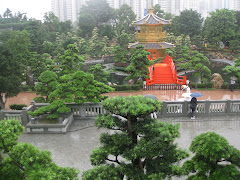Our first stop in Peru was Puno, a small town on the shores of Lake Titicaca. We visited two islands on the lake; Taquile Island (thanks Cathy, Ashley, Phillipa and Charlotte!) and one of the floating Uros Islands (thanks Ellen and Stuart & Sandra!). Taquile island reminded me of Italy - it was green and hilly, with sandy beaches, clear water and views of snow capped mountains in Bolivia. We met some locals, who gave us peppermint tea (it tasted like a mix between peppermint and thyme - tasty) and we watched the men knitting and the women weaving. Knitting is solely a man's job, as it is easier than the finicky, intricate weaving the women were doing. The men all wore hats to denote their marital status; a white hat flopped over one ear meant he was single, whilst a folded white hat meant that he was in a relationship. A coloured hat with blue shot through meant he was married. Women wore large black cloths on their head, which also doubled as handy carrying bags which they wrapped around their shoulder to carry weaving, shopping and babies. The black headscarf originated from the hijab, which was brought over from southern Spain, but the women adapted the scarfs to have large, colourful pom-poms at each corner. Large, bright pom-poms meant the women was single, whereas smaller, muted pom-poms meant that she was married.
 |
| Taquile island overlooking the Bolivian mountains |
 |
| Taquile gents knitting |
Taquile islanders have a unique custom with regard to marriage. When a young couple decide they want to get married, they first live together in their parents' house for one year, to decide whether they are well matched. If at the end of this year they decide that they no longer want to commit, both walk away unscathed. During this year, the girl will weave her betrothed a belt
made from her hair to wear on the wedding day. There are never any pregnancies during this trial year, as the couple both take a daily contraceptive drink made from plants on the island. This custom feels refreshingly modern (although I'm not so keen on the belt-hair part!).
 |
| Arch from the cover of the Peru lonely planet |
We next visited the Uros floating islands. These were conceived out of necessity; the tribes originally lived in the banks of the lake, but were forced to take to the water after being invaded and taken over by other tribes. The islands are made of reeds, and only last 15 years, with a weekly top up of reeds required. The base of the islands are made from roots of reeds which are sewn together. Lots of layers of cut reeds are then placed over the top. This makes the islands spongy and springy, much like walking on a bouncy castle. The islands are about 10x10 metres and hold up to five families on each. Chickens, ducks and cats also live on the islands. Recently the islands have included solar panels, which power TVs. The islanders fish from boats (also made from reeds) and sell their wares to tourists. Children travel daily to the mainland to go to school. As the islanders technically don't live on any land, the Peruvian government doesn't recognise them as citizens and they do not get any help from the state. They also have to be careful that their islands don't float into Bolivian waters, as they don't own passports.
 |
| Uros floating island |
 |
| House on Uros - see the solar panel? |
 |
| Uros children |
















No comments:
Post a Comment